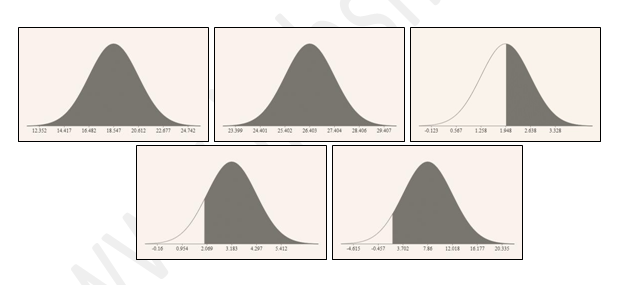FRAMING NORMS FOR THE PHYSICAL PERFORMANCES FOR PATHANKOT COLLEGIATE GIRLS
DOI:
https://doi.org/10.55968/ijobsms.v12i01.463Keywords:
Physical Performance, Collegiate Girls, NormsAbstract
The aim of this study was to frame norms for the physical performances for Pathankot collegiate girls. 450, subjects from selected collage of Pathankot affiliated to Guru Nanak Dev University, Amritsar were selected for the present study. These above aims erect the respective study objectives: To find out the Descriptive Statistics (Mean & Standard Deviation) and (Hi & Low). To determine the Distribution of Grades under Normal Distribution, further it will be graded in into five grades i.e., Excellent, Good, Average, Poor, Very Poor. In 100 M: - The score Below
14.41 was considered excellent, between 14.41-16.48 was considered good, between 16.48-20.61 was considered average, between 20.61-22.67 was considered poor although, the scores Above
22.67 was considered very poor. In 200 M: - The score Below 24.40 was considered excellent, between 24.40-25.40 was considered good, between 25.40-27.40 was considered average, between 27.40-28.40 was considered poor although, the scores Above 28.40 was considered very poor. In Long jump: - The score Above 3.32 was considered excellent, between 3.32-2.63 was considered good, between 2.63-1.25 was considered average, between 1.25-0.56 was considered poor although, the scores Below 0.56 was considered very poor. In Shot-Put: - The score Above 5.41 was considered excellent, between 5.41-4.29 was considered good, between 4.29-2.06 was considered average, between 2.06-0.95 was considered poor although, the scores Below 0.95 was considered very poor. In Javelin Throw: - The score Above 16.17 was considered excellent, between 16.17-12.01 was considered good, between 12.01-3.70 was considered average, between 3.70-0.45 was considered poor although, the scores Below 0.45 was considered very poor.
Metrics
References
Bouchard, C.; Shephard, R.J.; Stephens, T.; Sutton, J.R.; McPherson, B.D. Exercise, Fitness, and Health: A Consensus of Current Knowledge; Human Kinetics: Champaign, IL, USA, 1990. DOI: 10.1001/jama.262.17.2395.
Blair, S.N. Physical fitness, and all-cause mortality. JAMA1989,262, 2395. DOI: 10.1001/jama.262.17.2395.
García-Hermoso, A.; Cavero-Redondo, I.; Ramírez-Velez, R.; Ruiz, J.R.; Ortega, F.B.; Lee, D.-C.; Martínez-Vizcaino, V. Muscular strength as a predictor of all-cause mortality in an apparently healthy population: A systematic review and meta-analysis of data from approximately 2 million men and women. Arch. Phys. Med. Rehabil.2018,99, 2100–2113. DOI: 10.1016/j.apmr.2018.01.008.
Sui, X.; LaMonte, M.J.; Blair, S.N. Cardiorespiratory fitness as a predictor of nonfatal cardiovascular events in asymptomatic women and men. Am. J. Epidemiol.2007,165, 1413–1423. DOI: 10.1093/aje/kwm031.
Yamamoto, K. Human flexibility and arterial stiffness. J. Phys. Fitness Sports Med.2017,6, 1–5. DOI: https://doi.org/10.7600/jpfsm.6.1.
Peterson, M.D.; Duchowny, K.; Meng, Q.; Wang, Y.; Chen, X.; Zhao, Y. Low normalized grip strength isa biomarker for cardiometabolic disease and physical disabilities among
U.S. and Chinese adults. J. Gerontol. Ser. A.2017,72, 1525–1531. DOI: https://doi.org/10.1093/gerona/glx031.
Singh, M., Kadhim, M.M., Turki Jalil, A. et al. A systematic review of the protective effects of silymarin/silibinin against doxorubicin-induced cardiotoxicity. Cancer Cell Int 23, 88 (2023). https://doi.org/10.1186/s12935-023-02936-4 https://cancerci.biomedcentral.com/articles/10.1186/s12935-023-02936-4
Singh, M., Kour, R., & Kour, A.,. A collaborative diversified investigation of respective responses of sports person coaches and organizations on criminalization of doping.International Journal of Health Sciences,6(S3), 11295–11310. https://doi.org/10.53730/ijhs.v6nS3.8641
SINGH SIDHU, A., & SINGH, M. (2022). KINEMATICAL ANALYSIS OF HURDLE CLEARANCE TECHNIQUE IN 110M HURDLE RACE. International Journal of Behavioral Social and Movement Sciences, 4(2), 28–35. Retrieved from https://ijobsms.org/index.php/ijobsms/article/view/267
Sawada, S.S.; Lee, I.-M.; Naito, H.; Kakigi, R.; Goto, S.; Kanazawa, M.; Blair, S.N. Cardiorespiratory fitness, body mass index, and cancer mortality: A cohort study of Japanese men. BMC Public Health2014,14, 1012.
Ortega FB, Ruiz JR, Castillo MJ, Sjostrom M. Physical fitness in childhood and adolescence: a powerful marker of health. Int J Obes (Lond). 2008;32(1):1–11.
Ruiz JR, Castro-Piñero J, Artero EG, Ortega FB, Sjostrom M, Suni J, et al. Predictive validity of health-related fitness in youth: A systematic review. British Journal of Sports

Additional Files
Published
How to Cite
Issue
Section
License
© 2025 International Journal of Behavioral Social and Movement Sciences. All Rights Reserved.
All content published in this journal, including articles, images, and other intellectual property, is protected by copyright law. No part of this publication may be reproduced, distributed, or transmitted in any form or by any means without the prior written permission of the publisher.
For permissions and inquiries, please contact us at: editor@theuniversityacademics.com
License Terms for Publications in International Journal of Behavioral Social and Movement Sciences
By submitting an article to the International Journal of Behavioral Social and Movement Sciences, authors agree to the following terms:
-
License Grant:
-
Authors retain copyright for their work. However, by submitting their work, authors grant the journal a non-exclusive, worldwide, royalty-free license to publish, reproduce, distribute, display, and otherwise use the article in any form and medium (print or digital) in perpetuity.
-
-
Open Access:
-
Articles published in this journal are made freely available to the public under the terms of an open-access license. The journal allows anyone to access, download, copy, distribute, print, search, or link to the full text of the articles.
-
-
Attribution:
-
Authors are required to provide proper citation and attribution to the original article when reusing or referencing content. The attribution should include the author(s), title of the article, journal name, volume, issue, and publication year.
-
-
Reuse of Material:
-
Authors may reuse their published work for non-commercial purposes, including reprinting in other publications or personal websites, provided proper attribution is given to the original publication.
-
-
Creative Commons License:
-
The journal may publish articles under a Creative Commons Attribution 4.0 International License (CC BY 4.0), which allows others to remix, adapt, and build upon the work, even for commercial purposes, as long as they give appropriate credit to the original author(s).
-
-
Peer Review:
-
The submitted article will undergo a thorough peer-review process, and the final decision regarding publication rests with the editorial board of the journal.
-
-
Withdrawal:
-
Once accepted for publication, articles may only be withdrawn with the approval of the editorial board and must not be published elsewhere in any form without prior written consent.
-
















